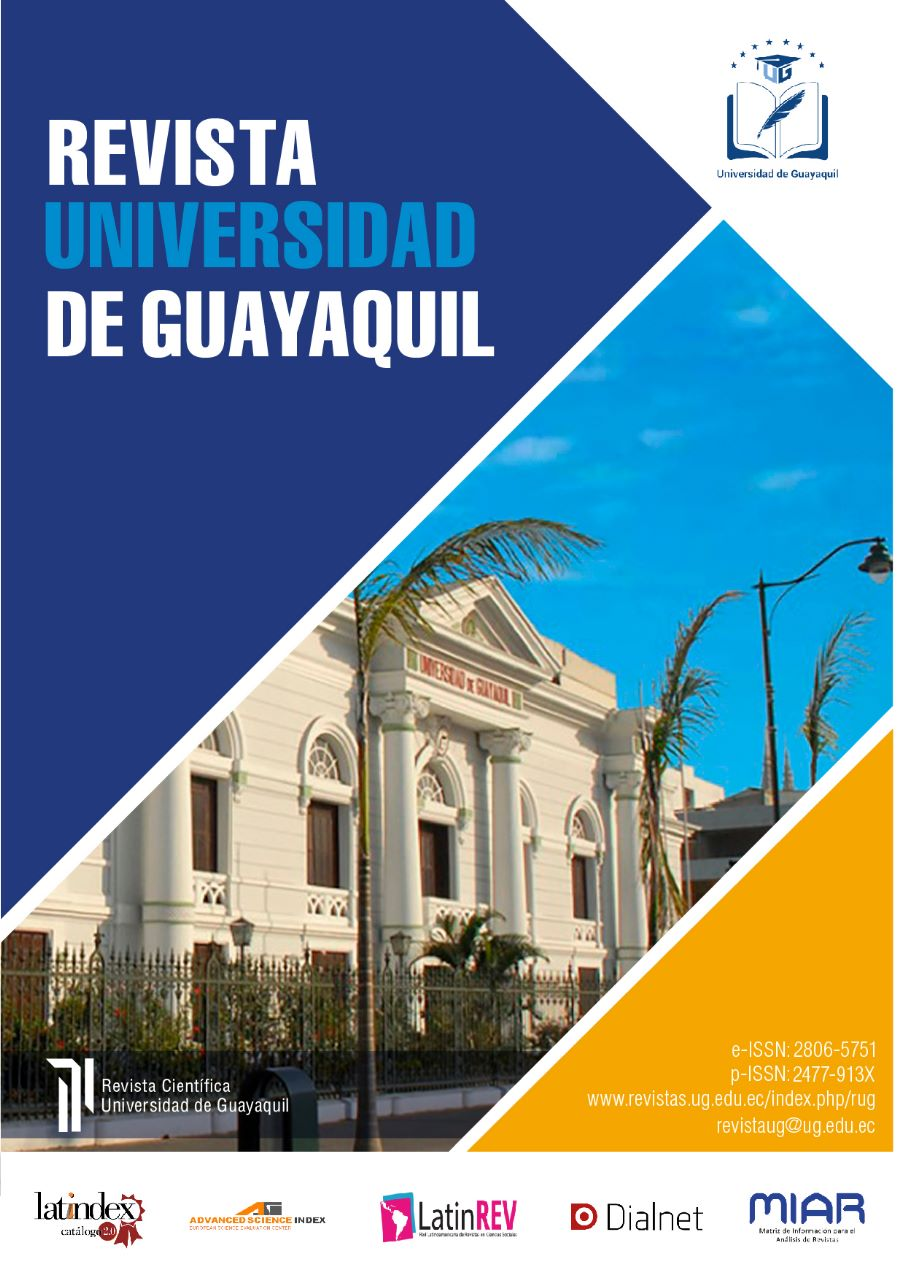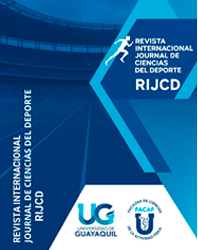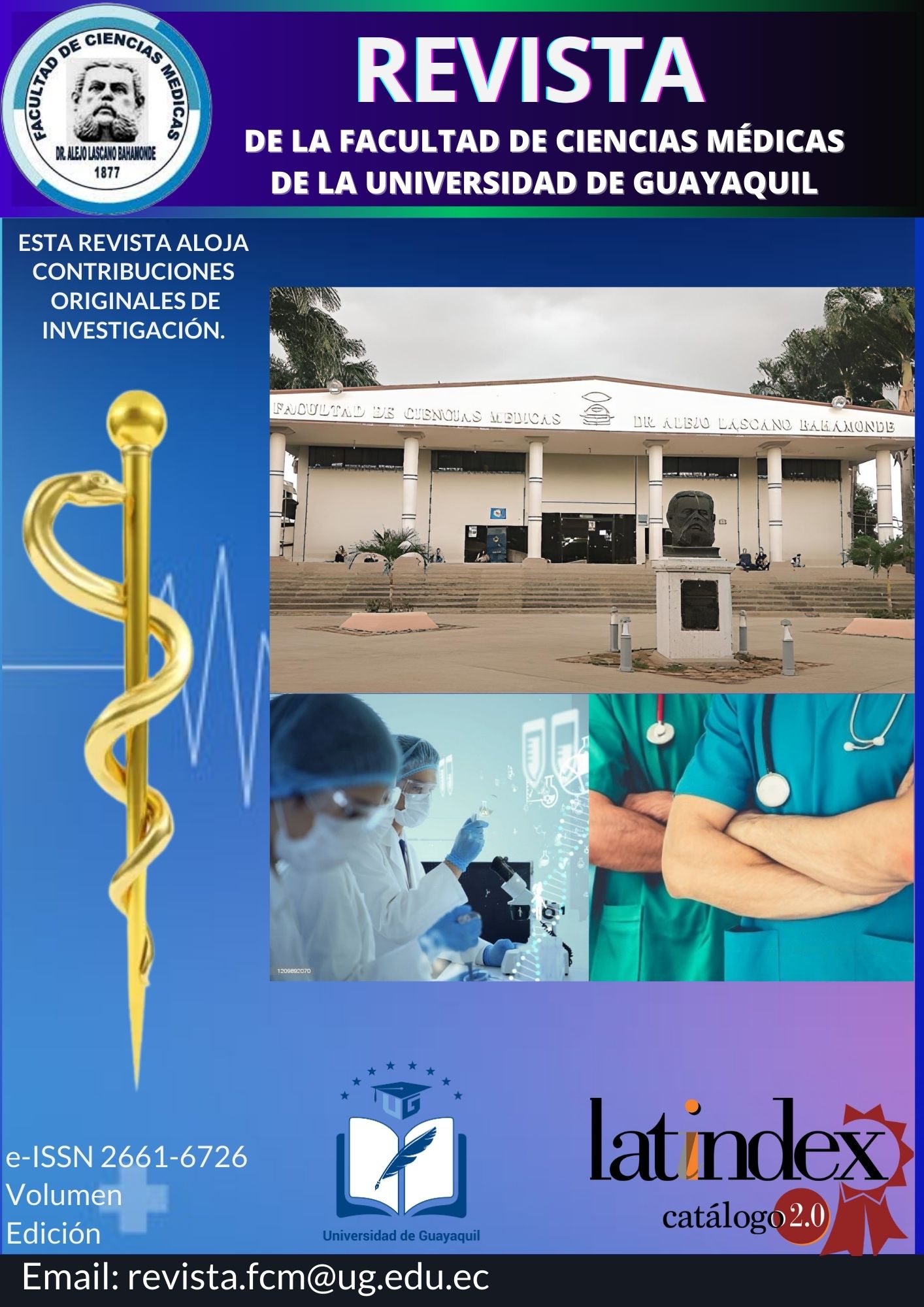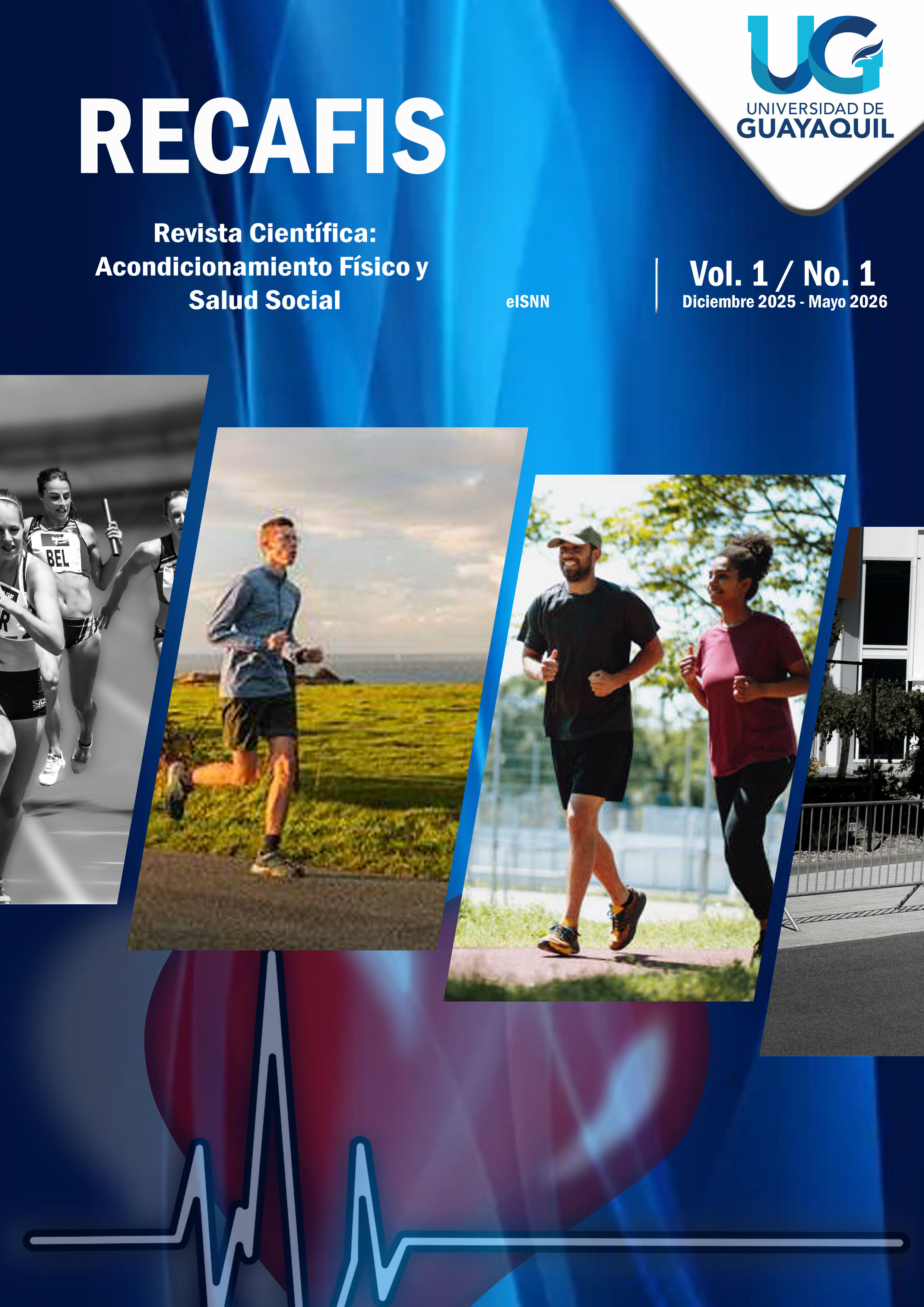Journals
-
Revista Universidad de Guayaquil
The journal Revista Universidad de Guayaquil (REVUG), published by the Universidad de Guayaquil, is an open-access, peer-reviewed, biannual academic journal committed to the dissemination of scientific knowledge since 1930. Its mission is to promote excellence and innovation in research by providing scholars, professors, and students with a rigorous and freely accessible platform for the publication of original and unpublished works, evaluated through a double-blind peer review process.
As of February 2024, the journal entered a new editorial stage, transitioning from a general multidisciplinary focus to an interdisciplinary approach within the Social Sciences. This redefinition aims to strengthen the journal’s academic identity and align its editorial practices with international indexing standards, fostering dialogue among disciplines such as Psychology, Economics and Business, Education, Sociology, Law, Political Science, and Communication, among other related areas.
All articles are published in Spanish and English, with translation services provided by the journal, and are indexed in major national and international databases, thereby enhancing the visibility and impact of its scientific contributions.
The journal is currently indexed in the following databases: AmeliCA, Biblat, Latindex Catalog 2. 0, LatinReV, Dialnet, I2OR, MIAR, CiteFactor, LivRe, IndexCopernicus, ADVANCED SCIENCES INDEX (ASI), Open Ukrainian Citation Index (OUCI), Open Academic Journal Index (OAJI), Directory of Research Journals Indexing (DRJI), Eurasian Scientific Journal Index (ESJI), Scilit, Scientific Indexing Services (SIS), ROAD, ResearchBib, Scientific Journal Impact Factor (SJIFactor), ROOTINDEXING, Sherpa/Romeo, Base, Dimensions, Crossref, Google Scholar, OpenAIRE Explore, ISSN.
-
Sport Science Training and Research
Sport Science Training and Research is an international, open-access scientific journal published twice a year with a double-blind peer-review process. Its purpose is to disseminate original research distinguished bymethodological rigor, theoretical robustness, and critical contributions inthe field of sport sciences and physical activity.
The journal covers a broad spectrum of topics related to the applied sciences in sport, long-term training and athletic development processes,the directions and evaluation of sports training, sports management and administration, social, recreational, and spectator sport, as well asadapted and Paralympic sport.
The target audience consists of researchers, university professors, physiotherapists, coaches, sports psychologists, and physical performance experts who are interested in the technological, scientific, and practical evolution of exercise and training in its various forms.
-
Revista Científica Ciencias Naturales y Ambientales
La Revista Científica de Ciencias Naturales y Ambientales, es una revista científica-académica de acceso abierto de la Facultad de Ciencias Naturales de la Universidad de Guayaquil.
Su objetivo es contribuir a la producción científica, su socialización y debate, en el ámbito de las Ciencias Naturales y Ambientales.
La publicación es semestral en los meses de junio y diciembre. Publica solo artículos de trabajos de investigación, comunicación científica o creación originales.
Dirigida a científicos, docentes y público en general. Código ISSN en línea: 2773-7772, código impreso: 1390-8417 .
Indexada en DOAJ, REDALYC, Latindex 2.0, Base, DOI y Crossref.
-
Revista Ecuatoriana de Ciencias Psicológicas
The Ecuadorian Journal of Psychological Sciences is an open-access, biannual scientific publication promoted by the Faculty of Psychological Sciences of the University of Guayaquil. Its purpose is to promote and disseminate original, ethical, and rigorous research across diverse areas of psychology—such as clinical, educational, organisational, and social psychology—that addresses the needs of the Ecuadorian and Latin American context. With a clear commitment to quality, epistemic equity, and editorial transparency, the journal seeks to consolidate its position as a regional reference in the dissemination of psychological knowledge, welcoming both theoretical and applied contributions from national and international authors.
-
Research, Technology & Innovation
Investigación, Tecnología e Innovación es una revista de acceso abierto, revisada por pares, de carácter científico, bilingüe y multidisciplinario.
Su principal objetivo es divulgar los resultados inéditos de investigaciones originales, en las áreas de: 1. Ciencias Naturales: Matemática, Computación y Ciencias de la Información; 2. Ingeniería y Tecnología: Ingeniería Civil, Ingeniería Eléctrica, Electrónica e informática, Ingeniería Mecánica; 4. Ciencias Agrícolas: Agricultura, Silvicultura y Pesca, Biotecnología Agrícola, Otras Ciencias Agrícolas; 5. Ciencias Sociales: Economía y Negocios, Ciencias de la Educación, Derecho, Ciencias Políticas, Periodismo y Comunicaciones; 6. Humanidades, según la Clasificación de Áreas Científicas de la Organización para la Cooperación y el Desarrollo Económicos (OCDE).
A la fecha se encuentra indexada en: LATINDEX Catálogo 2.0, MIAR, DIALNET, LatinRev, REDIB, Index Copernicus, AmeliCA, ERIHPLUS. Investigación, Tecnología e Innovación no cobra por ingreso, procesamiento o publicación de artículos.
Entidad editora: Universidad de Guayaquil, Facultad de Ciencias Matemáticas y Físicas, Ecuador.
Frecuencia de publicación: Semestral (publica el primer número el 31 de mayo y el segundo número el 30 de noviembre).
Correo de contacto: revistaiti@ug.edu.ec -
REVISTA DE LA FACULTAD DE CIENCIAS MÉDICAS
Revista sobre ciencia de la salud de carácter científico de acceso abierto; cuya finalidad es difundir informacion científica en salud y resultados de investigacones para contribuir a la formacion científica del lector.
Dirigido a estudiantes de pregrado, profesionales e investigadores de la salud.
Actualmente se encuentra indexada en las Base de datos: Latindex Catalogo 2.0
-
Revista Científica ESPECIALIDADES ODONTOLÓGICAS UG
La Revista Científica Especialidades Odontológicas UG es un medio digital que tiene por objetivo publicar artículos científicos originales relacionados con el área de las ciencias de la salud.
Está orientada a investigadores, estudiantes y maestros que se dedican al tema de la odontología y aspectos generales de las ciencias de la salud, por lo tanto se difunden artículos de investigación, presentaciones de caso, artículos de oposición y revisiones sistemáticas que promuevan en los lectores el pensamiento crítico y analítico para que amplíen su conocimiento acerca de las ciencias de la salud y la Odontología.
La Revista Científica Especialidades Odontológicas UG es editada y dirigida por la Facultad de Odontología de la Universidad de Guayaquil.
Actualmente la revista se encuentra indexada en las Bases de Datos: DOAJ, Redalyc, Latindex Catálogo 2.0, EBSCO, AmeliCA, OAJI, Periódica, Dialnet, REDIB, MIAR, Google Académico, CrossRef.
-
Revista Minerva
Revista Minerva (ISSN 2953-6316) es una publicación electrónica de carácter científico, es gratuita y de acceso abierto, se dedica a la publicación semestral de artículos resultados de investigaciones originales en español e inglés que abarcan una variedad de temas relacionados con educación y formación docente.
La revista es editada por la Universidad de Guayaquil, Facultad de Filosofía, Letras y Ciencias de la Educación.
El propósito de la revista es difundir resultados de investigación de centros, universidades y entidades dedicadas al desarrollo de la sociedad en general.
La Revista Minerva está dirigida a docentes, investigadores y a la comunidad académica en general.
Indexaciones.
- Latindex Catálogo: https://www.latindex.org/latindex/ficha/27405
- Dialnet: https://dialnet.unirioja.es/servlet/revista?codigo=27685
- ROAD: https://portal.issn.org/resource/ISSN/2953-6316#
-
Artes: Architecture, Technology and Sustainability
ARTES. Revista científica editada por la Facultad de Arquitectura y Urbanismo de la Universidad de Guayaquil, creada en el año 2022.
Está especializada en difundir resultados de investigación científica académica en las áreas de Arquitectura, Urbanismo, Construcción, Historia, Patrimonio, Diseño Interior e Ingeniería abordadas desde diferentes escalas.
Se prioriza la calidad de las colaboraciones, su originalidad, pertinencia temática, sistematización y rigor científico.
Frecuencia de publicación: Semestral, publica el primer número el 30 de Junio, el segundo número el 31 de Diciembre.
-
EASI: Engineering and Applied Sciences in Industry
EASI: Engineering and Applied Sciences in Industry provides an international multidisciplinary forum for researchers and professionals from academia, industry, and government to discuss challenges related to flexibility and interoperability in industry, as well as the relationship between industry and society. Published since July 2022, it is released biannually in January and July. We stand out for maintaining a focus on areas of work related to interoperability and Industry 4.0, such as supply chain management, industrial automation, cybersecurity in industrial networks, cyber-physical systems, and Education 4.0 in engineering, among others, which together offer authors a range of possibilities for disseminating their research results.
EASI is published in two versions: print (ISSN: 3073-1526) and electronic (e-ISSN: 2953-6634), in English and identified with a Digital Object Identifier System (DOI: 10.53591).
EASI is indexed in Latindex, catálogo 2.0, Amelica, LivRe, Periódica, Google Académico, Miar , Dialnet and Road.
-
Scripta Mundi
La Revista Scripta Mundi (ISSN 2960-8031) es una publicación electrónica de carácter científico de la FACULTAD DE CIENCIAS DE LA COMUNICACIÓN SOCIAL (FACSO) DE LA UNIVERSIDAD DE GUAYAQUIL.
Es gratuito y de acceso abierto, solo se reciben artículos originales e inéditos en el campo de la comunicación (periodismo, comunicación visual y audiovisual) diseño gráfico, publicidad. También se reciben investigaciones en ciencias sociales de preferencia que tengan alguna relación con la comunicación; educación, turismo, emprendimiento, innovación y marketing.
Es una revista que publica dos números al año, el primer número en enero, corresponde al primer semestre de enero a junio, mientras que el segundo en julio y corresponde de julio a diciembre.
Está dirigido a investigadores, profesores, estudiantes, profesionales y expertos nacionales o extranjeros en el área de la comunicación y otros campos relacionados.
A la fecha se encuentra indexada en: Latindex 2.0, GoogleScholar, Dialnet, MIAR, Europub. LATINREV. Miembros de la Red de Editores y Revistas Científicas Ecuatorianas (RERCIE)
-
Revista ION-CQ
La revista ION-CQ es un nuevo medio de divulgación científica, humanística, especializada en el área de Ciencias Químicas, creada por el Facultad de Ciencias Químicas de la Universidad de Guayaquil. Esta revista persigue posicionarse en los principales portales de indización, a través de las investigaciones científicas de calidad que se publicaran en ella. Posee un alcance nacional e internacional, y se mantiene abierta a todos los docentes e investigadores.
La revista ION-CQ es una publicación periódica de aparición semestral, en español, aunque se reciben publicaciones en inglés, está arbitrada bajo el sistema de doble ciego; es una revista de acceso abierto. Sus investigaciones están destinadas a dar aportes a la comunidad científica para mejorar la calidad en los procesos, teniendo siempre como objetivo principal la difusión de estudios en los ámbitos de la química, bioquímica, farmacéutica y la salud, con la intención de aportar nuevo conocimiento al acervo científico.
La revista está dirigida a investigadores, docentes, estudiantes y comunidad en general involucrados en los temas de acontecer químico y sus derivados que generen avances científicos sobre estudios en la química y bioquímica. Los artículos recibidos por ION-CQ serán revisados, arbitrados y aceptados, según resultados arrojados por la evaluación para su posterior edición y publicación.
El proceso de edición Enfoques, se encuentra sometido bajos las normas y los estándares de control de calidad, garantizando la originalidad, pertinencia y actualidad de los artículos aceptados y publicados a través del establecimiento de principios de ética y políticas de detención de plagio.
-
Revista de la Facultad de Ciencias Económicas
La Revista de la Facultad de Ciencias Económicas se propone como objetivo contribuir al fortalecimiento y construcción de una nueva identidad en la academia ecuatoriana, constituyéndose como un órgano plural de difusión de la ciencia económica. Para ello invita a profesores, investigadores, estudiantes y profesionales en economía a presentar trabajos de investigación para su eventual publicación.
Desde el 2023 la Revista de la Facultad de Ciencias Económicas se publica de forma semestral, con ediciones disponibles en mayo y noviembre de cada año.
La revista se encuentra indexada en LATINDEX Catálogo 2.0, MIAR, Dialnet, ICI Journals Master List (Index Copernicus), LatinREV, Google Académico.
La convocatoria permanece abierta durante todo el año.
-
RIAF. International Journal of Physical Activity
"RIAF". International Journal of Physical Activity: A Publication of the Faculty of Physical Education, Sports, and Recreation of the University of Guayaquil, Ecuador.
An open-access digital journal with double-blind peer review, published every four months, which features original articles that demonstrate scientific rigor, theoretical soundness, and critical analysis.
Its thematic scope includes General Physical Activity Sciences, School and Health Physical Education, Sports Training, Therapeutic Physical Activity, Recreation, Sports, Fitness Physical Activity, Applied Sciences to Physical Activity, and Physical Activity for Health.
Its target audience consists of university professors, physical education teachers at all educational levels, sports coaches, sports physicians, nutritionists, sports psychologists, physical rehabilitators, therapists, and physical instructors.
This journal is indexed in ROAD, Dialnet, LatinRev, Google Scholar and Latindex Directorio
-
Conexiones UG
La Revista Científica Internacional con rigurosidad académica del Decanato de Vinculación con la Sociedad y Bienestar Estudiantil de la Universidad de Guayaquil, Ecuador.
CONEXIONES UG, es una Revista Electrónica de acceso abierto con arbitraje a doble ciego con una frecuencia de publicación semestral, de artículos de alto rigor científico desde una perspectiva transdisciplinaria dirigida al ámbito de comunidades científico-sociales a nivel nacional e internacional.
El objetivo fundamental de la Revista, es difundir temas orientados al impulso científico–social para la resolución de problemas fundamentales de las realidades socioeducativas y comunitarias de distintos niveles socioculturales y económicos, tanto del Ecuador como de los espacios del mundo en los que sea pertinente.
Revista CONEXIONES UG informa que se reciben de manera permanente contribuciones. Todas las contribuciones deben aportar lo siguiente:
Manuscrito sin los datos del(os) autor(es), e Información del manuscrito, y autores.IMPORTANTE: Todas las contribuciones deben ser enviadas a través de esta plataforma web. Caso contrario no se iniciará el proceso de revisión y posterior publicación, si lo amerita.
-
International Journal of Studies in Administrative Sciences STRATEGOS
ISSN: 1390-9568 | ISSN-L: 3073-1291
STRATEGOS, the International Journal of Studies in Administrative Sciences, is an open-access academic publication, edited by the University of Guayaquil, that disseminates original research in the areas of administration, leadership, business economics, accounting, finance, and entrepreneurship. Its objective is to contribute to the circulation of scientific knowledge generated in the field of administrative sciences from a critical and applied perspective.
Submitting articles to the journal implies acceptance of its editorial, ethical, and evaluation policies. STRATEGOS does not charge fees for submission or publication of articles and adheres to the principles of open access and scientific dissemination without economic restrictions for readers or authors.
This journal publishes original articles of theoretical and applied research (not case studies, nor descriptive, exploratory, or correlational studies) in Spanish and English in the following areas:
Accounting and Auditing
Management and Leadership
Business Economics
Entrepreneurship
Business Environment
Finance
Foreign Trade
International Business
Tourism
Sustainable Development -
ECOAgropecuaria. Revista Científica Ecológica Agropecuaria
La Revista ECOAgropecuaria es un medio de divulgación científica de acceso abierto y gratuito (no hay costo por procesamiento de artículos), que se publica semestralmente (junio y diciembre), creada por las Facultades de Ciencias Agrarias y Medicina Veterinaria y Zootecnia de la Universidad de Guayaquil.
El objetivo de la revista es publicar artículos científicos inéditos de investigaciones experimentales originales de interés para las comunidades científicas y productores en áreas de las Ciencias Agropecuarias y afines.
Las áreas temáticas que aborda la revista son las siguientes: Ciencias de las plantas, Botánica, Biológicas, Biotecnología Agropecuaria, Recursos Naturales, Ingeniería Ambiental, Agroprocesos, Alimentos y bebidas, Agroeconómica, Química de hidrocoloides y biopolímeros. Ciencias de los animales, salud y producción animal, reproducción, genética y mejora animal, nutrición animal, economía y desarrollo agropecuario, clínica veterinaria y afines.
ISSN DE ENLACE 2953-6596
ISSN DE IMPRESO 3091-1710
Indexado en AMELICA.
-
Derecho Crítico: Revista Jurídica, Ciencias Sociales y Políticas
Derecho Crítico es una revista académica dedicada a la publicación de investigaciones y análisis críticos en el campo del derecho, las ciencias sociales y las ciencias políticas. La revista se enfoca en promover una comprensión profunda y crítica de los problemas jurídicos y sociales contemporáneos, destacando la intersección entre estas disciplinas y su impacto en la sociedad.
La revista está dirigida a académicos, investigadores, profesionales del derecho, estudiantes y todos aquellos interesados en el análisis crítico de las cuestiones jurídicas y sociales. Publica artículos, ensayos, reseñas y estudios de caso que abordan temas relevantes y actuales, fomentando una perspectiva interdisciplinaria y crítica.
Derecho Crítico se destaca por su compromiso con la excelencia académica y la promoción de un discurso crítico y reflexivo, buscando siempre aportar al conocimiento y a la mejora de las prácticas jurídicas y sociales.
Datos de la Revista:
- ISSN-e: 2953-6464
- ISSN: 3091-1664
- Inicio: 2022
- Periodicidad: Semestral
- País: Ecuador
- Idioma: español
- Arbitraje: Revisión por pares doble ciego
-
INQUIDE - Ingeniería Química y Desarrollo
INQUIDE - Ingeniería Química y Desarrollo, is edited by the Faculty of Chemical Engineering of the University of Guayaquil, Ecuador.
We are an international, bilingual, multidisciplinary, open access scientific journal that publishes peer-reviewed scientific articles. We publish articles in English and Spanish.Ingeniería Química y Desarrollo is published biannually; the first issue on January 1, the second issue on July 1; and there is no charge for admission, processing or publication of articles. The review time for scientific articles is 1.5 to 3 months.
Email: inquide@ug.edu.ec / francisco.duquea@ug.edu.ec
Objective of INQUIDE Journal
INQUIDE – Chemical Engineering and Development aims to disseminate original, relevant, and academically rigorous research that advances theoretical or practical knowledge in science and engineering. The journal prioritizes studies that contribute to methodological, technological, or professional innovation and align with the Sustainable Development Goals (SDGs).INQUIDE – Chemical Engineering and Development is an interdisciplinary scientific journal focused on publishing original research in engineering, applied science, and sustainable development. Its editorial approach promotes technological advancement, industrial innovation, and responsible resource management, in alignment with the Sustainable Development Goals (SDGs):
-
SDG 7: Affordable and clean energy
-
SDG 9: Industry, innovation and infrastructure
-
SDG 12: Responsible consumption and production
-
-
Scientific Journal: Physical Conditioning and Social Health
COMITÉ EJECUTIVO:
Dr. Francisco Morán Peña,
Ph.D. Rector de la Universidad de Guayaquil.
ORCID: 0000-0003-3655-6003Ing.
Sofía Lovato Torres
Ph.D.Vicerrectora Académica de la Universidad de Guayaquil.
ORCID: 0000-0001-5831-8554Ing.
Oswaldo Baque Jiménez
Ph.D. Decano de Formación Académica y Profesional de la Universidad de
Guayaquil.
Amalín Mayorga Albán
Ph.D. Decana de Investigación
Postgrado e Internacionalización de la Universidad de Guayaquil.
ORCID: 0000-0002-3667-0888
Juan Fernández Escobar
Mgs. Decano de Vinculación con la Sociedad y Bienestar Estudiantil de la
Universidad de Guayaquil.
ORCID: 0000-0002-1890-533XB.
María Tamara Ortiz Luzuriaga
Mgs. Coordinadora de Investigación y Gestión del Conocimiento de la Universidad
de Guayaquil.
ORCID: 0000-0002-9849-9350
Alfonso Aníbal Guijarro Rodríguez
MSc. Editor General de Revistas de la Universidad de Guayaquil.
ORCID: 0000-0001-6046-426XIng.
Luis Pilacuán Bonete
Ph.D. Coeditor General de Revistas de la Universidad de Guayaquil.
ORCID: 0000-0002-6625-0905
Mgs. Álvaro Espinoza Burgos
Decano de la Facultad de Ciencias de la Actividad Física
ORCID:
Mgs. Hugo Ángulo Corozo
Sub decano de la Facultad de Ciencias de la Actividad Física
ORCID:NIVEL DIRECTIVO:
Editor: PhD Alex Perlaza. Docente Investigador, Miembro del Equipo de
Investigación en Salud UG- FACAF. Gestor de Vinculación.
Editora de Sección/Co-Editora de la Revista: Post PhD Daisy Meza Palma. DhC. Gestora Académica del Vicerrectorado Académico. UG. Docente Investigadora, Miembro del Equipo de
Investigación en Salud UG- FACAF.
Director de la Revista: PhD. Älvaro Diego Espinoza Burgos. Decano FACAF. Docente
Investigador, Miembro del Equipo de Investigación en Salud UG- FACAF.Consejo de la Revista: Órgano Superior de la Revista Integrado por:
Nivel Ejecutivo:
Editor. PhD Alex Perlaza. Docente Investigador, Miembro del Equipo de
Investigación en Salud UG- FACAF.
Editora de Sección/Co-editora. Post PhD Daisy Meza Palma. Gestora Académica del Vicerrectorado Académico. UG. Docente Investigadora, Miembro del Equipo de Investigación en Salud UG- FACAF.
Director: PhD. Álvaro Diego Espinoza Burgos. Decano FACAF, Miembro del
Equipo de Investigación en Salud UG- FACAF. Docente Investigador.
Miembro Representante del Comité Editorial:
PhD. Antonio Ricardo Rodríguez Vargas. Docente Investigador en el Área de la Actividad
Física y Sistemas Inclusivos. FACAF-UG. Ecuador.COMITÉ EDITORIAL
1. PhD. Antonio Ricardo Rodríguez Vargas. Docente Investigador en el Área de
la Actividad Física y Sistemas Inclusivos. FEDER-UG. Ecuador.
2. PhD. Alejandro Labrador. UCV. Salud Pública y Estudios Ergonómicos.
Venezuela.
3. Mgs Nicold Altamirano. Docente investigadora UG- FACAF. Gestora de
Vinculación.
4. PhD. Glenda Velázquez. Docente investigadora UG- Facultad de Medicina.
Ecuador.
5. Mgs . Ricardo Ortega Oyarvide. Director de Carrera. UG-FACAF. Ecuador.
6. Mgs. Carlem Gimón. UC- FCS. Medicina. Docente Investigadora Extranjera.
UC- Venezuela.
7. PhD. Iris Terán. UC. UNIESAP – FCS.Salud Pública. Medicina.Investigadora
Extranjera. Venezuela.
8. PhD.Mayli Tang. UC. UNIESAP – FCS.Salud Pública Medicina. Investigadora
Extranjera. Venezuela.
9. PhD. María Chacón. UC. UNIESAP – FCS. Salud Pública Medicina.
Investigadora Extranjera. Venezuela.
10. Mgs. Alida Farías. UC. UNIESAP – FCS. Salud Pública Medicina.
Investigadora Extranjera. Venezuela..
11. PhD. Iruxa Roa. Centro de Investigaciones Psicológicas. Investigadora
Extranjera.
12. PhD. Adriana Yaguachi. Coordinadora del equipo de investigación en salud UGFEDER. Ecuador.
13. Doctora María Triolo Mieses. Bioanalista. Especialista en Estudios de
Antienvejecimiento. Universidad de Chile.COMITÉ CIENTÍFICO INTERNACIONAL DE REVISORES
1- Ph.D. Rafael Acosta Pereira. Investigador Educativo de Actividad Física. IND
Venezuela.
2- Mgs. Darley Burgos. Miembro del Equipo de Investigación en Salud. UG-FACAF. Ecuador.
3- Post PhD Fedor Alí Meza. Universidad Pedagógica Experimental Libertador.
Investigador Extranjero en Actividad Física, Educación y Salud. Venezuela.
4- Post PhD. Miguel Cartaya Olivares. Red Internacional de Investigadores.
Varios países.
5- PhD. Iván Medina. Investigador Extranjero en Actividad Física, Educación y
Salud. Argentina.
6- Médico. Paola Hurtado. Formación en Sistemas Nutricionales. Universidad de
Guayaquil FACAF. Ecuador.
7. PhD Alexander Brito Taboada. Investigador en Actividad Física, Educación y
Salud. Universidad de Guayaquil FACAF. Ecuador.
8. PhD Aracely Moraima Cabeza Toro. Docente Investigadora de la Universidad
Técnica de Babahoyo. Ecuador.
9. PhD Roberto Brionis. Universidad Católica Santiago de Guayaquil. Docente
Investigador. Medicina. Ecuador.
10. PhD Efren Viteri Chiriboga. Sub Decano de la Facultad de Psicología.
Universidad de Guayaquil. Ecuador.
11. PhD Susana Mata. Decana de la Facultad de Psicología. Universidad de
Guayaquil. Ecuador.
12. Mgs. Mayré Dictamen. Psicóloga Clínica. Investigadora en Salud. Venezuela.
13. PhD. Verónica María Valle Delgado. Formación en Terapia Respiratoria.
Docente Egresada del Centro de Estudios para la Calidad Educativa y la
Investigación Científica. México.
14.PhD Lourdes María Velázquez Lores. Área Médica. Universidad César
Vallejos. Perú.
15. PhD. Lisbeth Guillen. Área de Cultura Física. Revista Gade. Cuba.
16. Mgs. Francisco Villao Villacres. Docente de Inglés. UG- FACAF.Nivel Operativo:
Traductor: Mgs. Francisco Villao Villacres. Docente de Inglés. UG- FACAF.
Diagramador/Técnico: Mgs. Walter Antón Espinoza.Sobre la Revista.
La Revista Científica Internacional de la Facultad de Educación Física Deportes y Recreación RECAFIS (Revista Científica: Acondicionamiento Físico y Salud Social) de la Universidad de Guayaquil, es una Revista Electrónica de acceso abierto con arbitraje a doble ciego con una frecuencia de publicación semestral de artículos de alto rigor científico desde una perspectiva Holística , dirigida a comunidades científicas de la Actividad Física en el ámbito del Acondicionamiento Físico en contextos de la Salud Social y Colectiva a nivel internacional. Se abordan en ella, temas referidos a: El Acondicionamiento Físico y Salud Social y Colectiva, Epistemologías del Acondicionamiento Físico Asociadas a la Salud Social y Colectiva, Sistemas Ergonómicos de Salud, Salud Preventiva, Terapéutica, Social Colectiva y Ocupacional, Observatorios de Salud y Violencia.
La Revista se desarrollará en dos idiomas: Español e Inglés.
-
Revista Internacional de Pedagogía de la Actividad Física y Deporte
REVISTA INTERNACIONAL DE PEDAGOGÍA DE LA ACTIVIDAD FÍSICA Y DEPORTE
La Revista Científica Internacional de la Facultad de Educación Física Deportes y Recreación de la Universidad de Guayaquil, Revista Internacional de Pedagogía de la Actividad Física y el Deporte (RIPAFD), es una Revista Electrónica de acceso abierto la cual se aborda desde arbitraje a doble ciego y se desarrolla con una frecuencia de publicación semestral desde una perspectiva multidisciplinar, dirigida a investigadores, académicos, profesionales, empresarios y estudiantes universitarios en el campo de la pedagogía de la actividad física y el deporte.
Su objetivo es incentivar una cultura investigativa para el progreso de la ciencia y la apropiación social del conocimiento a fin de transformar la realidad de los diferentes contextos en los distintos subniveles de enseñanza a nivel nacional e internacional.





















